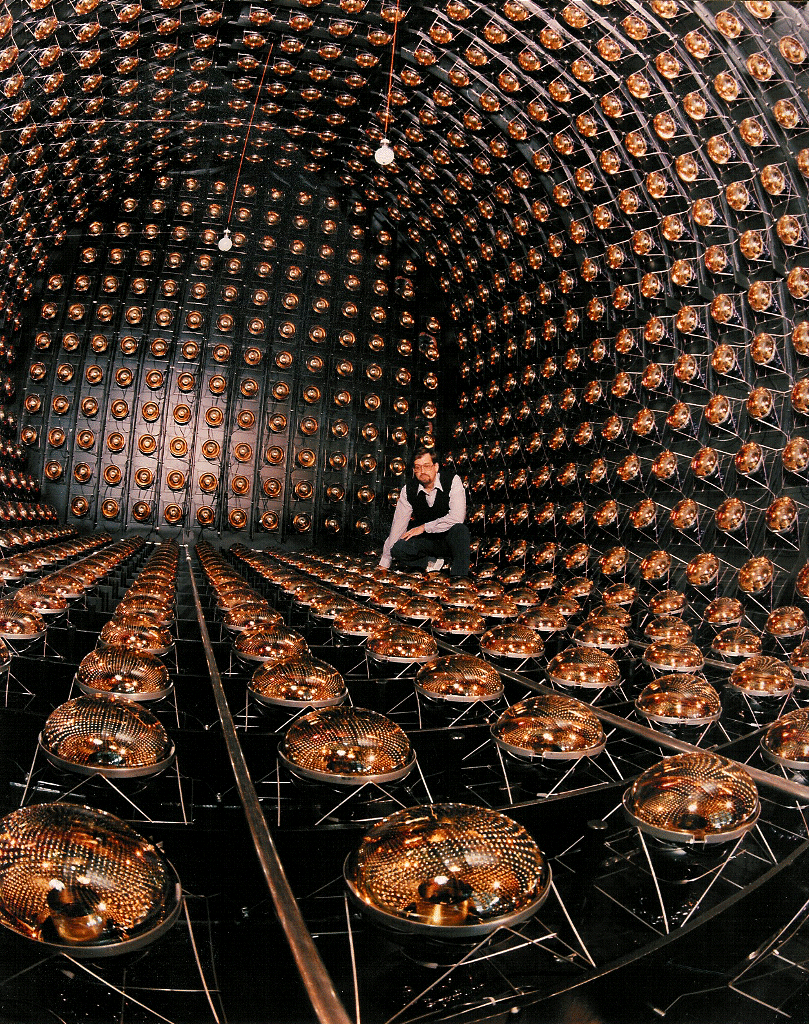In 1993, deep underground at Los Alamos National Laboratory in New Mexico, a few flashes of light inside a bus-size tank of oil kicked off a detective story that is yet to reach its conclusion.
The Liquid Scintillator Neutrino Detector (LSND) was searching for bursts of radiation created by neutrinos, the lightest and most elusive of all known elementary particles. “Much to our amazement, that’s what we saw,” said Bill Louis, one of the experiment’s leaders.
The problem was that they saw too many. Theorists had postulated that neutrinos might oscillate between types as they fly along—a hypothesis that explained various astronomical observations. LSND had set out to test this idea by aiming a beam of muon neutrinos, one of the three known types, toward the oil tank, and counting the number of electron neutrinos that arrived there. Yet Louis and his team detected far more electron neutrinos arriving in the tank than the simple theory of neutrino oscillations predicted.
Since then, dozens more neutrino experiments have been built, each grander than the last. In mountains, disused mining caverns, and the ice beneath the South Pole, physicists have erected cathedrals to these notoriously slippery particles. But as these experiments probed neutrinos from every angle, they kept yielding conflicting pictures of how the particles behave. “The plot keeps thickening,” said Louis.
“It’s a very confusing story. I call it the Garden of Forking Paths,” said Carlos Argüelles-Delgado, a neutrino physicist at Harvard University. In Jorge Luis Borges’ 1941 short story of that title, time branches into an infinite number of possible futures. With neutrinos, contradictory results have sent theorists down a variety of paths, unsure which data to trust and which might be leading them astray. “Like any detective story, sometimes you see clues and they throw you in the wrong direction,” Argüelles-Delgado said.
In 1993, the Liquid Scintillator Neutrino Detector at Los Alamos National Laboratory reported a puzzling bounty of neutrino detections. Rick Bolton, an engineer, is shown kneeling among the photomultiplier tubes that would detect light from neutrino interactions inside the tank once it was filled with mineral oil.Courtesy of Los Alamos National Laboratory
The simplest explanation of the LSND anomaly was the existence of a new, fourth kind of neutrino, dubbed the sterile neutrino, that mixes up all the neutrino types according to new rules. Sterile neutrinos would allow muon neutrinos to oscillate more readily into electron neutrinos over the short distance to the oil tank.
But as time went on, the sterile neutrino didn’t fit the results of other experiments. “We had our champion theory, but the problem was that elsewhere it fails miserably,” Argüelles-Delgado said. “We were very deep in the forest, and we needed to come out.”
Forced to retrace their steps, physicists have been rethinking what’s behind the muddle of hints and half results. In recent years, they’ve devised new theories that are more complicated than the sterile neutrino, but which, if correct, would thoroughly revolutionize physics—resolving anomalies in neutrino oscillation data and other major mysteries of physics at the same time. Not least, the new models posit heavy additional neutrinos that could account for dark matter, the invisible stuff enshrouding galaxies that seems to be four times more abundant than normal matter.
Now, four analyses released yesterday by the MicroBooNE experiment at the Fermi National Accelerator Laboratory near Chicago and another recent study from the IceCube detector at the South Pole both suggest that these more complex neutrino theories may be on the right track—though the future remains far from clear.
“I feel like something’s in the air,” said Argüelles-Delgado. “It’s a very tense environment that points toward discovery.”
A Desperate Remedy
When Wolfgang Pauli postulated the existence of the neutrino in 1930 to explain where energy was disappearing to during radioactive decay, he called it a “desperate remedy.” His theoretical construct had no mass or electric charge, making him doubt an experiment could ever detect it. “It is something no theorist should ever do,” he wrote in his journal at the time. But in 1956, in an experiment not unlike LSND, there the neutrino was.
Triumph soon veered into confusion when physicists detected neutrinos coming from the sun, a natural source of the particles, and found fewer than half the number predicted by theoretical models of stars’ nuclear reactions. By the 1990s, it was clear that neutrinos were behaving oddly. Not only did solar neutrinos seem to mysteriously disappear, but so too did the neutrinos that fall to Earth when cosmic rays collide with the upper atmosphere.




